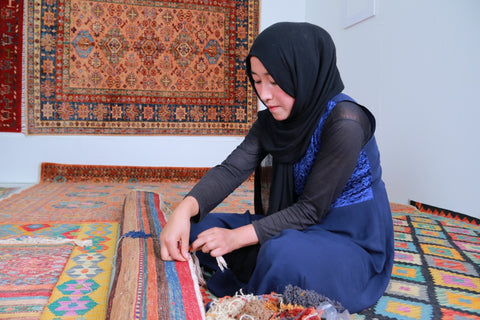
Afghan rugs are an iconic symbol of Afghan culture and heritage. They are intricately designed, hand-knotted carpets that are traditionally woven in Afghanistan by skilled artisans, like most of the Afghan women we choose to work with weave our rugs. These carpets are renowned for their craftsmanship, intricate designs, and vibrant colors, and they have been a major source of income for Afghan women for centuries.
Though Afghan rugs have been a symbol of Afghan culture for centuries, the role of Afghan women in the creation of these carpets is often overlooked. Afghan women are essential to the weaving process, as they have the necessary talent and attention to detail needed to create these stunning pieces of art. The Rug Mine seeks to shift that narrative and give these women the spotlight they deserve!

The weaving process begins with the selection of the premium Afghan wool. Afghan women must select wool with the right softness, strength, and color to create the desired look and feel of your heirloom rug. Once the wool has been selected, it is hand-spun into yarn. This is a labor-intensive process and requires a great deal of skill and attention to detail.
Once the yard is spun, it is then dyed using fruits, vegetables, and plants. This process requires a great deal of skill, as the artisans must create the perfect combination of colors and shades to create a unique and beautiful rug.

The yarn is then woven into the rug. This process is perhaps the most important and time-consuming aspect of creating an Afghan rug. It requires a great deal of skill and patience to ensure that each knot is tightly woven and that the design is symmetrical. The rug is then washed and finished to create the desired look. Finally, the rug is ready to be sold and enjoyed by our amazing clients.

Many of our clients don't realize this, but in addition to the physical and manual labor involved in creating an Afghan rug, Afghan women also play an crucial role in the design process. Many of the intricate, traditional designs featured on Afghan rugs (and many of our rugs) are thought to have been passed down through generations of Afghan women. Each of these designs has a unique cultural, ethnic, nomadic, or tribal meaning, and these meanings are often shared with the weaver, who, in turn, can create a rug that is true to the original design meaning.
You can see the entire rug-making process here.

Afghan women are essential to every step of the process and without their skill, dedication, and attention to detail, exquisite and unique Afghan rugs could not be created. The Rug Mine is shifting that narrative in a number of ways.
First, the majority of the rug-weaving artisans we work with are women (over 3,000 of them in the last two years).
Second, we've partnered with local women (who are either studying abroad or who have graduated with university degrees) to explore fair trade initiatives in Afghanistan — that means intense research about artisans' working conditions, their pay, and understanding the history and nuances of Afghanistan's elaborate rug business.
Finally, we've begun a historic initiative to pay Afghan women up to 50% more than what they're typically paid for their hard work. Suffice to say, their typical pay is unacceptable.

The role of Afghan women in the creation of Afghan rugs is invaluable. Without their skill, dedication, and attention to detail, our exquisite and unique Afghan rugs could not be created. Their role in the creation of these carpets is often overlooked, but their contribution is essential and should be celebrated.
